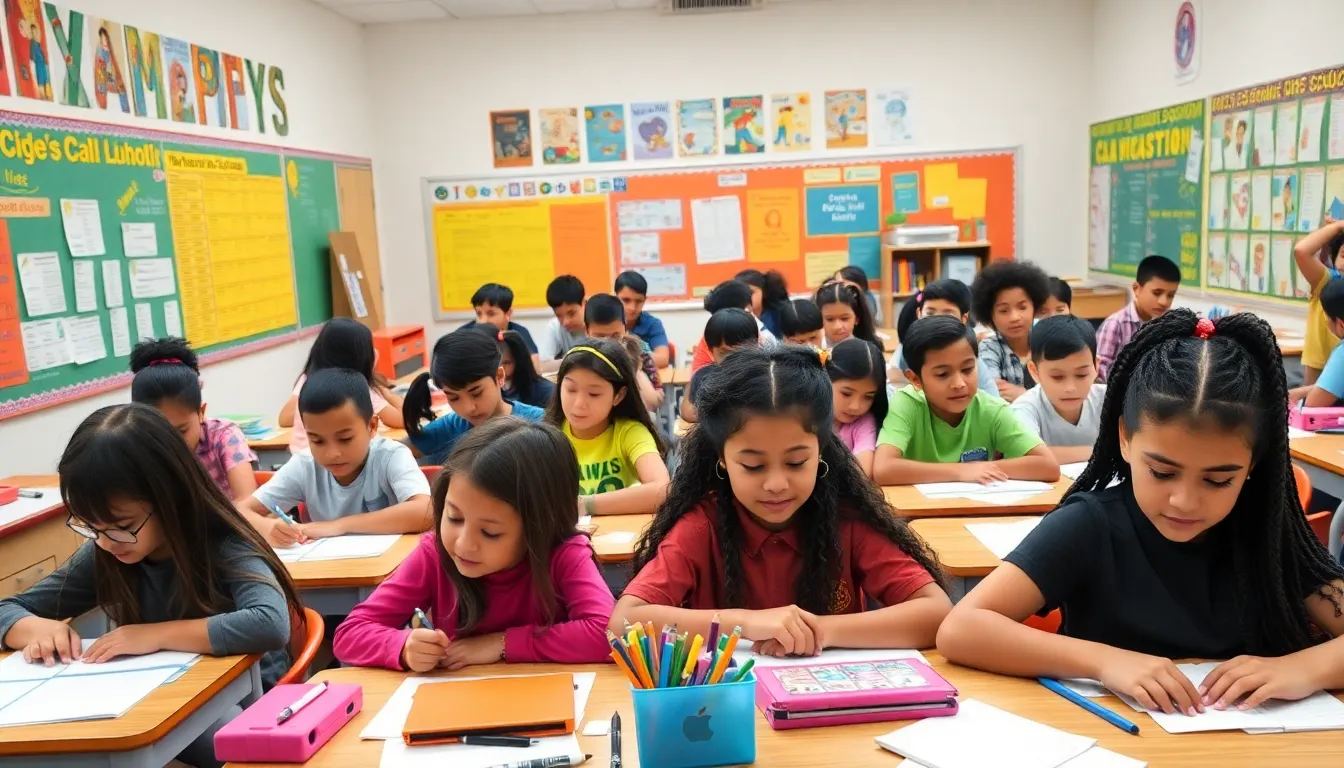Table of Contents
ToggleIn today’s fast-paced world, K-12 education faces challenges that would make even the most seasoned educators scratch their heads. From the relentless march of technology to the ongoing debates over curriculum content, it’s a wild ride for students and teachers alike. Who knew that navigating the classroom could feel like a game of educational dodgeball?
As schools strive to adapt, issues like mental health, equity, and funding are at the forefront of discussions. Parents, teachers, and policymakers are all in the mix, trying to figure out how to best prepare the next generation for a future that’s as unpredictable as a cat on a Roomba. Join the conversation as we dive into the current issues shaping K-12 education today and explore how they impact everyone involved in this crucial journey.
Overview of Current Issues in K-12 Education Today
K-12 education faces significant challenges today that affect students, educators, and communities. Technology integration has transformed the learning landscape, prompting debates about screen time, access, and digital literacy. Curriculum development emerges as a key issue, with discussions surrounding educational standards, inclusivity, and relevance to current societal needs.
Mental health concerns have gained prominence within schools, highlighting the necessity for support systems that address students’ emotional well-being. Educators often report increasing rates of anxiety and depression among students, signaling an urgent need for resources and training in mental health awareness.
Equity remains a pressing concern, as disparities in educational opportunities persist based on geographic location, socioeconomic status, and race. Many students lack access to advanced courses or extracurricular programs, widening achievement gaps. Funding challenges exacerbate these issues, with many districts facing budget cuts that limit resources for classrooms and staff.
Policy developments also play a critical role in shaping the educational environment. Legislative changes can impact teacher recruitment, evaluation standards, and overall educational funding. Stakeholders must navigate these complexities as they work to advocate for an equitable and effective K-12 educational system.
Parents and community members increasingly engage in conversations about school policies and curricula, reflecting a growing demand for transparency and collaboration. Schools that prioritize open communication with families often see enhanced community support and student achievement.
Funding Challenges

Funding challenges significantly impact K-12 education. Financial disparities affect resources, staffing, and educational quality.
Public vs. Private Funding
Public funding plays a crucial role in supporting K-12 education, primarily sourced from local, state, and federal taxes. Allocation often varies, leading to significant differences in educational quality across districts. Private funding sources, such as donations and grants, supplement public funding but don’t fully address gaps. Wealthier schools frequently benefit from larger donations, increasing the resources available for students. Charitable foundations also provide funds, yet their availability fluctuates based on economic conditions. Maintaining a balance between public and private funding remains critical to ensure all students receive quality education.
Impact of Budget Cuts
Budget cuts create immediate challenges for K-12 schools. Reduced funding directly leads to layoffs, fewer programs, and crowded classrooms. Teachers often face increased workloads, which can diminish instructional quality. Essential services, such as counseling and extracurricular activities, commonly experience cuts that impact student well-being and engagement. Limited budgets often necessitate prioritizing core subjects, leaving arts and vocational programs underfunded. Long-term effects can hinder student academic performance and overall growth, perpetuating educational inequities. Addressing budget cuts is essential for maintaining a supportive and enriching learning environment.
Teacher Shortages
Teacher shortages present significant challenges in K-12 education today, impacting both educators and students alike. These shortages stem from various pressing factors that require immediate attention.
Causes of Teacher Exodus
High turnover rates among teachers result from issues like low salaries, demanding workloads, and insufficient support. Compensation often fails to reflect the effort required for effective teaching. Many educators face classroom sizes that exceed manageable limits, making teaching exceptionally challenging. Furthermore, limited resources hinder teachers’ ability to provide quality education. Burnout also emerges as a common concern due to the emotional and physical toll placed on educators. A lack of professional development opportunities leaves teachers feeling stagnant and undervalued in their roles.
Effects on Student Learning
Student learning suffers significantly due to teacher shortages. Reduced teacher-to-student ratios impede personalized instruction, leading to disengaged learners. Inconsistent teaching quality often results from a reliance on substitute teachers, impacting lesson continuity. Various studies indicate that students in schools with high turnover rates show lower academic performance compared to those in stable environments. Mental health and emotional well-being of students also decline, as they miss the supportive relationships that experienced teachers provide. Overall, these factors contribute to widening educational gaps, affecting students’ long-term success.
Technology Integration
Technology integration in K-12 education offers new learning possibilities while presenting distinct challenges. The adoption of online learning platforms enhances access to diverse educational resources. Students engage with interactive content and personalized learning experiences that cater to varying academic needs. Flexibility becomes essential, allowing learners to balance their studies with other responsibilities. Furthermore, online learning can foster collaboration among peers through discussion forums and group projects.
Advantages of Online Learning
Online learning provides students numerous advantages that traditional classrooms cannot match. Increased accessibility enables students to attend classes from anywhere, promoting education for those in remote areas. The diverse range of resources available online caters to varied learning styles, ensuring engagement for visual, auditory, and kinesthetic learners. Skills such as self-discipline and time management are cultivated, preparing students for higher education or the workforce. This modern approach to learning supports individualized instruction, addressing specific academic challenges and strengths.
Digital Divide Concerns
The digital divide remains a pressing issue in K-12 education, affecting equitable access to technology. Disparities in internet connectivity and device availability hinder opportunities for many students. Rural and low-income families frequently lack reliable access, widening the gap between affluent and disadvantaged communities. Schools must prioritize infrastructure improvements and resource allocation to bridge this gap. Ensuring that all students possess the tools necessary for success is crucial, as digital literacy becomes an essential skill in the modern workforce. Addressing digital equity promotes inclusive education and maximizes learning potential for every student.
Mental Health Awareness
Mental health awareness in K-12 education tackles rising anxiety and depression among students. Schools play a critical role in fostering supportive environments.
Importance of Support Systems
Creating effective support systems proves essential for student well-being. Mental health professionals in schools contribute significantly to early intervention and prevention efforts. Access to school counselors and psychologists leads to enhanced student coping strategies. Parents, teachers, and staff must collaborate to build a community-focused approach. Recognizing signs of distress in students can result in timely assistance, reducing the stigma associated with mental health issues.
Strategies for Improvement
Implementing mental health programs provides vital resources for students. Educational workshops equip students and staff with skills to navigate mental health challenges. Establishing peer support groups encourages open discussions, fostering a sense of belonging. Training educators on mental health first aid empowers them to recognize and assist students in need. Additionally, integrating mental health education into the curriculum helps normalize conversations around mental wellness.
Curriculum Reforms
Curriculum reforms focus on enhancing educational experiences while addressing emerging issues in K-12 education.
Addressing Diversity and Inclusion
Schools prioritize diversity and inclusion in curriculum reforms to reflect the needs of a diverse student body. Incorporating materials that represent various cultures promotes understanding and empathy among students. Educators aim to create inclusive environments where every student feels seen and valued. Training for teachers on cultural competency encourages them to engage with all learners effectively. As more schools implement multicultural curricula, they foster critical thinking and awareness of social issues. Research shows that diverse educational content can improve student engagement and academic performance.
Balancing Standardized Testing
Standardized testing impact debates continue as educators seek to find a balance between assessments and holistic teaching. Emphasis on test scores often overshadows other critical learning aspects. Schools face pressure to meet performance benchmarks while fostering creativity and critical thinking skills. Combining formative assessments with standardized tests allows for a clearer view of student progress. Flexibility in testing schedules provides opportunities for diverse learners to demonstrate their abilities without undue stress. Policymakers push for reforms that lessen the reliance on standardized testing, advocating for more comprehensive evaluation methods that support student growth and achievement.
K-12 education faces a myriad of challenges that require urgent attention and collaborative efforts. As technology continues to reshape the learning environment schools must address the digital divide to ensure all students have equal access to resources. Mental health support is crucial for fostering well-being among students while curriculum reforms must embrace diversity and inclusivity to reflect today’s society.
Equity in education remains a significant concern with funding disparities impacting the quality of education offered. Teacher shortages further complicate the landscape limiting personalized instruction and hindering student engagement. By prioritizing these issues and fostering community involvement stakeholders can work together to create a more equitable and effective educational system that prepares students for the future.







